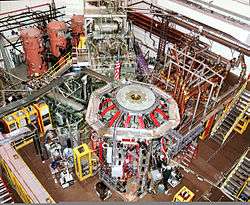National Spherical Torus Experiment
The National Spherical Torus Experiment (NSTX) is a magnetic fusion device based on the spherical tokamak concept. It was constructed by the Princeton Plasma Physics Laboratory (PPPL) in collaboration with the Oak Ridge National Laboratory, Columbia University, and the University of Washington at Seattle. It entered service in 1999. In 2012 it was shut down as part of an upgrade program and became NSTX-U, for Upgrade.
| National Spherical Torus Experiment | |
|---|---|
 NSTX in 2009 | |
| Device Type | Spherical tokamak |
| Location | Princeton, New Jersey, US |
| Affiliation | Princeton Plasma Physics Laboratory |
| Technical specifications | |
| Major Radius | 0.85 m (2 ft 9 in) |
| Minor Radius | 0.68 m (2 ft 3 in) |
| Magnetic field | 0.3 T (3,000 G) |
| Heating power | 11 MW |
| Plasma current | 1.4 MA |
| History | |
| Year(s) of operation | 1999 – present |
| Preceded by | Tokamak Fusion Test Reactor (TFTR) |
| Links | |
| Website | NSTX-U official website |
.jpg)
The spherical tokamak (ST) is an offshoot of the conventional tokamak design. Proponents claim that it has a number of practical advantages over these devices, some of them dramatic. For this reason the ST has seen considerable interest since it was proposed in the late 1980s. However, development remains effectively one generation behind mainline efforts such as JET. Other major experiments in the field include the pioneering START and MAST at Culham in the UK.
NSTX studies the physics principles of spherically shaped plasmas—hot ionized gases in which nuclear fusion will occur under the appropriate conditions of temperature and density, which are produced by confinement in a magnetic field.
History
1999–2012
First plasma was obtained on NSTX on Friday, February 12, 1999 at 6:06 p.m.
Magnetic fusion experiments use plasmas composed of one or more hydrogen isotopes. For example, in 1994, PPPL's Tokamak Fusion Test Reactor (TFTR) produced a world-record 10.7 megawatts of fusion power from a plasma composed of equal parts of deuterium and tritium, a fuel mix likely to be used in commercial fusion power reactors. NSTX was a "proof of principle" experiment and therefore employed deuterium plasmas only. If successful it was to be followed by similar devices, eventually including a demonstration power reactor (e.g. ITER), burning deuterium-tritium fuel.
NSTX produced a spherical plasma with a hole through its center (a "cored apple" profile; see MAST), different from the doughnut-shaped (toroidal) plasmas of conventional tokamaks. The low aspect ratio A (that is, an R/a of 1.31, with the major radius R of 0.85 m and the minor radius a of 0.65 m) experimental NSTX device had several advantages including plasma stability through improved confinement. Design challenges include the toroidal and poloidal field coils, vacuum vessels and plasma-facing components. This plasma configuration can confine a higher pressure plasma than a doughnut tokamak of high aspect ratio for a given, confinement magnetic field strength. Since the amount of fusion power produced is proportional to the square of the plasma pressure, the use of spherically shaped plasmas could allow the development of smaller, more economical and more stable fusion reactors. NSTX's attractiveness may be further enhanced by its ability to trap a high "bootstrap" electric current. This self-driven internal plasma current would reduce the power requirements of externally driven plasma currents required to heat and confine the plasma.
Upgrade 2012–2015
.jpg)
The NSTX-U (Upgrade) was completed in 2015. It doubles the toroidal field (to 1 Tesla), plasma current (to 2 MA) and heating power. It increases the pulse duration by a factor of five.[1] To achieve this the central stack (solenoid) was widened.[2] [3]
Recovery 2016–2021 +
The NSTX-U (Upgrade) was stopped in late 2016 just after its update due to a particular dysfunction of its poloidal coils. The NSTX had been shut down since 2012 and only returned for 10 weeks at the end of 2016 just after it was updated. The origin of this failure is partly attributed to a non-compliance of the chilled copper winding, the manufacture of which had been sub-treated. After a diagnostic phase requiring the complete dismantling of the reactor and coils, a restarting plan is adopted in March 2018. Reactivation of the reactor is not planned until the end of 2020.[4][5][6] Recent information from PPPL officials predicts the summer of 2021 to complete the NSTX-U recovery plan.[7]
References
- The Role of the Spherical Tokamak in the U.S. Fusion Energy Sciences Program Menard, 2012
- "PPPL to launch major upgrade of key fusion energy test facility". Princeton Plasma Physics Lab. Jan 2012.
- "NSTX-U Press Kit". Princeton Plasma Physics Lab.
- "NSTX-U recovery plan" (PDF). Princeton Plasma Physics Lab.
- "NSTX-U recovery plan" (PDF). NSTX-U recovery project.
- "review of NSTX-U recovery plan" (PDF). S. P. Gerhardt, et al.
- ChoFeb. 6, Adrian; 2020; Am, 8:00 (2020-02-06). "After decades of decline, the U.S. national fusion lab seeks a rebirth". Science | AAAS. Retrieved 2020-02-07.CS1 maint: numeric names: authors list (link)
Sources
- "National Spherical Torus Experiment". Princeton Plasma Physics Laboratory. Retrieved 2014-03-02. – Original source for this article was an earlier version of this page.
- "Schematic diagram of NSTX". Princeton Plasma Physics Laboratory. Retrieved 2009-08-07.
- Schematic diagram of NSTX-U Facility Upgraded Components